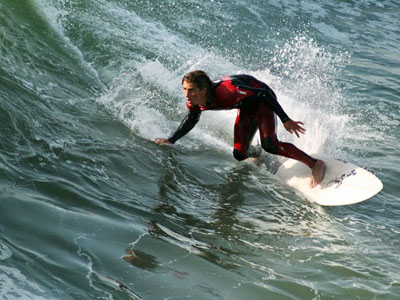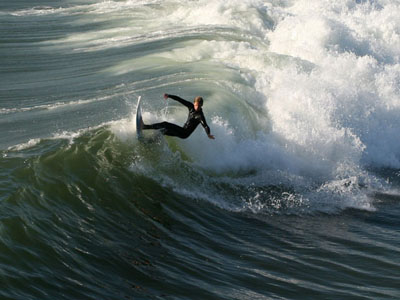| By Brocken Inaglory (Own work) [GFDL (http://www.gnu.org/copyleft/fdl.html) or CC-BY-SA-3.0-2.5-2.0-1.0 (http://creativecommons.org/licenses/by-sa/3.0)], via Wikimedia Commons |
Photographing surfing is potentially dangerous, and anyone undertaking such an assignment should be sure to obtain and observe responsible, professional and local advice before setting out from the beach. Surfing photography can be undertaken from the shore, or from a pier or jetty, but it may be difficult to get close to the action. A super-telephoto lens brings the subject closer but is an expensive item of equipment which is not necessarily easy to use.
Photographers who decide to get in the water close to the real action face numerous problems. Apart from the possibility of drowning, they risk losing or damaging expensive photographic equipment, suffering broken bones, being run over or even attacked by sharks. However, it is out in the surf where the stunning images are to be found.
It is not necessarily the case that expensive photographic equipment must be used. Simple amateur cameras - film or digital - can be used to produce excellent images. Clearly whatever equipment is used must either be waterproof or enclosed in a suitable waterproof housing.
 |
| Public domain image courtesy of Andrew Schmidt |
As with all photography, the quality of the light is important. Early morning light is excellent for surf photography, as may be late afternoon light. The least suitable time of day is when the sun is high and the light flat. Overcast days are less appropriate for similar reasons - particularly for colour images. Back-lighting can give an image a magical glow which transforms every flying droplet into a diamond, so use it wherever possible. Front lighting is the next best option.
The second major consideration is being in the right place at the right time. This is not easy to achieve in a large surf but expert local advice and assistance is clearly important. It is also vital to keep out of the way of the surfers. Safety considerations apart, a photographer causing an obstruction will soon become unpopular.
 |
| Public domain image courtesy of Andrew Schmidt |
Practice is of course essential. Only by spending many hours in the water, and taking hundreds of images, can a photographer hope to close in on the one breathtaking image he seeks. The images should be reviewed regularly, with the surfers where possible, to learn what mistakes are being made and put in place corrective action for the following sessions.
Technique is difficult to specify because it is inevitably personal and must be learned by bitter experience. However, a photographer must position himself so he is pulled up the face of the wave as it curls over, and use both hands to point a heavy waterproof camera housing at the passing surfer. As he approaches the top of the wave, the photographer must fire off a couple of exposures and try to escape through the back of the wave.







